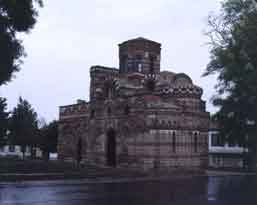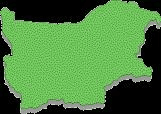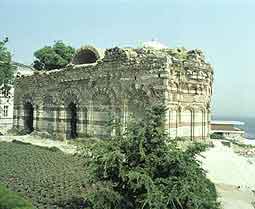|
Nesebar (Nesebur) |
|
||||||
|
A
town, 38 km north-east of Bourgas. Climatic seaside resort. Population of
8600.
The old quarter of the town, situated on Nesebur peninsula and linked to the mainland by a narrow neck of land. Declared an architectural and archaeological reserve. North and south of the peninsula there stretch beach strips covered with the finest sand along the Black Sea coast. To the north these are linked with the beaches of Slantchev Bryag. Nesebur is one of the oldest towns in Bulgaria. Ancient polis Mesambria appears in 6 c. B.C. in place of a Thracian settlement Melsabria (2nd - 1st millennium B.C.). Invaded by the Romans (1 c. B.C.), conquered by khan Krum in 812 and annexed to the Bulgarian state. Efflorescence as a sea port and cultural center reached under tsar Ivan Aleksandur (1331 - 1371). About 1452 Nesebur falls under Ottoman yoke and the fortress walls are demolished. During the Bulgarian National Revival the town is revived anew. Develops as a fishing and vine-growing center. Since antiquity to the present day there have been preserved sections of the fortress wall, towers, a gate, sanctuaries, inscriptions, relief's. Remarkable sites of Nesebur are its medieval churches. In the past these were more than 40, but only a few are still standing. Early Christian are basilicas, most famous among these - the Old Bishopric. The construction and plastic decorative peculiarities of Nesebur churches dating back to 10 - 14 c., sets them apart in a separate group, characteristic with the picturesque design of facades. Mural ornamentation of each church constitutes unique harmony of stone, red brick, multicolored ceramic rosettes and circular plates. Cross-dome churches are represented by "Sveti Ivan Krustitel" church (10 - 11 c.), "Sveti Arhangeli Mihail I Gavrail" (13 c.), "Pantokrator" (14 c.) and "Sveti Ivan Neosveteni" (14 c.). Single-naved are "Sveti Todor" and "Sveta Paraskeva" churches, "Sveti Stefan" church is a basilica (New Bishopric). In 1958 archaeological excavations uncover a medieval golden treasure of adornments which is kept in the historical museum of Bourgas. The Bulgarian National Revival architectural ensemble encompasses some 60 houses, picturesquely overhanging narrow cobbled streets. Architectural design is typical of the Black Sea coast house - stone basement, paneled upper floor, numerous bay windows, supported by corbels. Of greater interest are the houses of Mouskoyani, captain Pavel, Bogatova house, Rousieva house, and others. A historical museum with branches - archaeological exposition in "Sveti Ivan Krustitel" church. A Turkish bath (18 - 19 c.) and 3 windmills are still preserved. The old town is included in the list of monuments of world cultural and natural heritage compiled at UNESCO.
Old Bishopric - built at the end of 5 c. or the beginning of 6 c. Cathedral of Mesemvria bishopric. Dimensions are impressive. The middle nave dominated in height and width, initially separated from the side ones by columns and after the reconstructions of 9 and 10 c. - with walls, cut through by semi-circular arches. "Sveti Stefan" (New Bishopric) - a church built in 12 c. though other sources date it back to the end of 10 c. It has been preserved almost in whole in its initial form. Here for the first time colour ceramic decoration is used. Mural paintings (14 - 19 c) of high artistic value have been preserved; most valuable are those dated 16 c. and the iconostasis icons. 
"Sveti Ivan Neosveteni" ("Aliturgetos") and "Pantokrator" - the most picturesque Bulgarian churches. Raised in 14 c. Exceptionally luxuriant plastic decoration. Lively wealth of colour of ceramic rosettes, decorative construction and plastic architectural elements create unique architectural-artistic effect. Captain's house - built in the Bulgarian National Revival style, situated on the high stone coast above the port. The elevated stone basement is occupied by store rooms on two levels. On the floor above there is a T-shaped parlour and 4 spacious rooms in the corners with open on the facade. A relief badge of the guild is in-built on the southern wall. Mouskoyani's house - follows almost the same inner design as Captain's house. The parlour has an abundantly decorated ceiling, adorned with a round rosette. An ethnographic exposition has been arranged in the house. |
|||||||
|
|
|||||||

